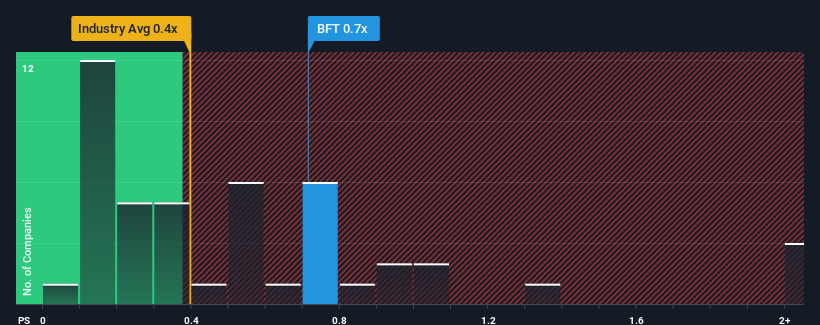Investors Still Aren't Entirely Convinced By Lincotrade & Associates Holdings Limited's (Catalist:BFT) Revenues Despite 46% Price Jump
The Lincotrade & Associates Holdings Limited (Catalist:BFT) share price has done very well over the last month, posting an excellent gain of 46%. While recent buyers may be laughing, long-term holders might not be as pleased since the recent gain only brings the stock back to where it started a year ago.
In spite of the firm bounce in price, you could still be forgiven for feeling indifferent about Lincotrade & Associates Holdings' P/S ratio of 0.7x, since the median price-to-sales (or "P/S") ratio for the Construction industry in Singapore is also close to 0.4x. However, investors might be overlooking a clear opportunity or potential setback if there is no rational basis for the P/S.
See our latest analysis for Lincotrade & Associates Holdings
What Does Lincotrade & Associates Holdings' Recent Performance Look Like?
With revenue growth that's exceedingly strong of late, Lincotrade & Associates Holdings has been doing very well. It might be that many expect the strong revenue performance to wane, which has kept the share price, and thus the P/S ratio, from rising. If that doesn't eventuate, then existing shareholders have reason to be feeling optimistic about the future direction of the share price.
Although there are no analyst estimates available for Lincotrade & Associates Holdings, take a look at this free data-rich visualisation to see how the company stacks up on earnings, revenue and cash flow.
What Are Revenue Growth Metrics Telling Us About The P/S?
There's an inherent assumption that a company should be matching the industry for P/S ratios like Lincotrade & Associates Holdings' to be considered reasonable.
Retrospectively, the last year delivered an exceptional 78% gain to the company's top line. Pleasingly, revenue has also lifted 273% in aggregate from three years ago, thanks to the last 12 months of growth. So we can start by confirming that the company has done a great job of growing revenue over that time.
This is in contrast to the rest of the industry, which is expected to grow by 21% over the next year, materially lower than the company's recent medium-term annualised growth rates.
With this information, we find it interesting that Lincotrade & Associates Holdings is trading at a fairly similar P/S compared to the industry. Apparently some shareholders believe the recent performance is at its limits and have been accepting lower selling prices.
The Final Word
Its shares have lifted substantially and now Lincotrade & Associates Holdings' P/S is back within range of the industry median. Using the price-to-sales ratio alone to determine if you should sell your stock isn't sensible, however it can be a practical guide to the company's future prospects.
We didn't quite envision Lincotrade & Associates Holdings' P/S sitting in line with the wider industry, considering the revenue growth over the last three-year is higher than the current industry outlook. There could be some unobserved threats to revenue preventing the P/S ratio from matching this positive performance. It appears some are indeed anticipating revenue instability, because the persistence of these recent medium-term conditions would normally provide a boost to the share price.
Don't forget that there may be other risks. For instance, we've identified 3 warning signs for Lincotrade & Associates Holdings (2 shouldn't be ignored) you should be aware of.
Of course, profitable companies with a history of great earnings growth are generally safer bets. So you may wish to see this free collection of other companies that have reasonable P/E ratios and have grown earnings strongly.
Have feedback on this article? Concerned about the content? Get in touch with us directly. Alternatively, email editorial-team (at) simplywallst.com.
This article by Simply Wall St is general in nature. We provide commentary based on historical data and analyst forecasts only using an unbiased methodology and our articles are not intended to be financial advice. It does not constitute a recommendation to buy or sell any stock, and does not take account of your objectives, or your financial situation. We aim to bring you long-term focused analysis driven by fundamental data. Note that our analysis may not factor in the latest price-sensitive company announcements or qualitative material. Simply Wall St has no position in any stocks mentioned.

